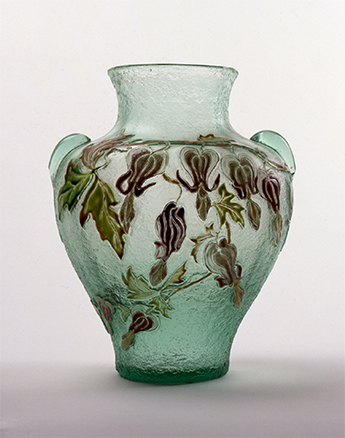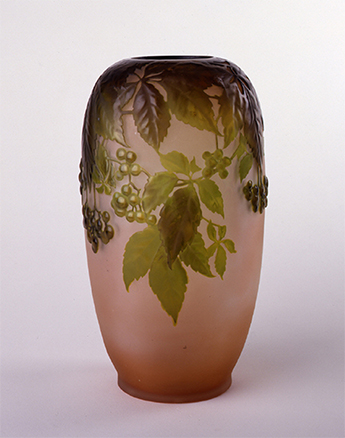Curators’ selection — Hidden Masterpieces
Emile GALLE, Vase, decorated with dragonfly and flower design, c. 1880-1900
Emile GALLE, Vase, decorated with dragonfly and flower design, c. 1880-1900
The pale brown glass is decorated with vegetation that seems to be growing effortlessly before our eyes and a dragonfly spreading its butterfly-like wings. The ribbed, undulating surface magnifies this vases’s dynamism and glitter.
The artist who created this vase was Émile Gallé (1846-1904), whose decorative style exemplifies Art Nouveau, an international art movement that sprang up in Europe from the late 19th through the early 20th century. Gallé was born in Nancy, a city in the Lorraine, east of Paris, the son of a family that manufactured glass and ceramics. After studying drawing and mould design in Weimar, Germany, in 1867 he began producing ceramics and glass at his father’s workshop. In 1889, he suddenly became famous by winning the Grand Prix at the Paris Exposition. Gallé played a major role in establishing glass, previously regarded as a craft, as an art.
The wealth of inspiration for Gallé’s new art, Art Nouveau, was not confined to Western Baroque and Rococo art. At the 1867 Paris Exposition and the 1871 London Exhibition, he discovered non-Western decorative motifs from Egypt, the Islamic world, China, and Japan. He embraced the lyricism of the fantastic worlds created in literature by authors in earlier periods as well as his contemporaries. To these sources, we can add his friendship, starting in 1885, with Takashima Hokkai (1850-1931), who lived in Nancy for three years. It was thanks to meeting Takashima that he was able to view vegetation and insects depicted using Japanese drawing techniques. Gallé was also a passionate horticulturalist who wrote many books about plants and grew and carefully studied more than 2,000 exotic plants in the two-hectare garden of the mansion his father had built. Nature inspired him in many different ways, as we can see in, for example, his Vase, with two handles, decorated with clematis design (fig. 1).
The delightful dragonfly depicted on this work is a motif that Gallé frequently addressed. The dragonfly is born as an aquatic larva, which later, as an adult lives on land. Its thin, transparent wings, captured in transparent or translucent glass, reawaken the viewer’s fascination with the vitality it embodies.
Gallé did not himself handcraft all of the works ascribed to him. These works were the products of a workshop with numerous employees and a division of labor. It produced both small numbers of luxury items and large numbers of low cost products, aiming to differentiate them at the finishing stage of the process. Following Gallé’s death, the workshop continued to produce these products until 1931, with great care taken to preserve the quality of the design in the mass-produced as well as the luxury items. Even now these works are filled with Galle’s spirit and delight the eyes of all who are privileged to see them (fig. 2).

- fig.1
- Emile GALLE, Vase, with two handles, decorated with clematis design

- fig.2
- GALLE Glassworks, Vase, decorated with bonny design
-
KAWAKAMI Ryoka, Early Summer, 1919, Oil on canvas
-
NAKAMURA Hochu, Flowers and Plants of the Four Seasons, Edo period, Early 19th century, Color on paper
-
AOKI Shigeru, Face, 1903-04, Colored pencil and wash on paper